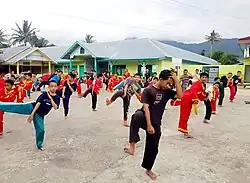
Tapak Suci Putera Muhammadiyah (lit. 'Sacred Palm, Sons of Muhammadiyah'), shortened as Tapak Suci, is an autonomous pencak silat martial arts organization of Muhammadiyah, the second largest modernist Muslim organization in Indonesia.[1][2][3] Tapak Suci is one of the ten 'historic schools' of IPSI (Ikatan Pencak Silat Indonesia, or Pencak Silat Association of Indonesia), the leading organization of pencak silat in Indonesia.[4]
The silat school was founded and made an official part of Muhammadiyah on July 31, 1963 in Yogyakarta[1][3] and has since spread nationwide within the organization.[1][5] The silat masters and practitioners in Muhammadiyah were concerned about the threatening situation confronting their members at that time, especially from various mass organizations that belonged to the Communist Party of Indonesia (PKI).[3]
Tapak Suci trains its members in physical silat techniques and breathing exercises.[3] The school, however, does not teach body invulnerability (ilmu kebal, which is taught by some more traditional silat schools), as it opposes cults and considers them shirk.[3][4][6]
As an autonomously managed part of Muhammadiyah, the martial arts school is open to membership not only of Muslims but to anyone interested, either in Indonesia or overseas chapters.[5]
See also
References
- 1 2 3 Maryono, O'ong; Keary, Lisa; Sciortino, Rosalia (2002). Pencak Silat in the Indonesian Archipelago. Yayasan Galang. p. 272. ISBN 9789799341600.
- ↑ Athyal, Jesudas M. (2015). Religion in Southeast Asia: An Encyclopedia of Faiths and Cultures: An Encyclopedia of Faiths and Cultures. ABC-CLIO. p. 186. ISBN 9781610692502.
- 1 2 3 4 5 Green, Thomas A.; Svinth, Joseph R. (2010). Martial Arts of the World: An Encyclopedia of History and Innovation. ABC-CLIO. p. 401. ISBN 9781598842449.
- 1 2 Wilson, Lee (2015). Martial Arts and the Body Politic in Indonesia. BRILL. p. 124-125, 166. ISBN 9789004289352.
- 1 2 Paetzold, Uwe U.; Mason, Paul H. (2016). The Fighting Art of Pencak Silat and its Music: From Southeast Asian Village to Global Movement. BRILL. p. 46-47. ISBN 9789004308756.
- ↑ Endres, Kirsten W.; Lauser, Andrea (2012). Engaging the Spirit World: Popular Beliefs and Practices in Modern Southeast Asia. Berghahn Books. p. 79. ISBN 9780857453594.